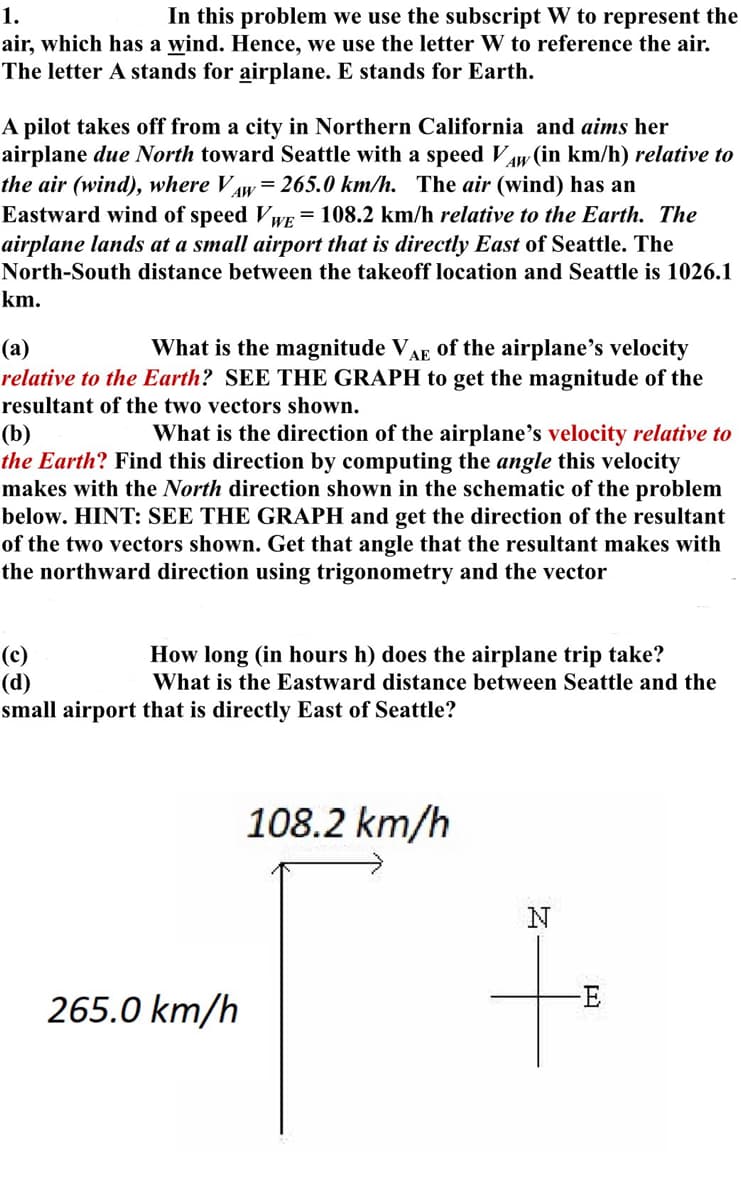In this problem we use the subscript W to represent the air, which has a wind. Hence, we use the letter W to reference the air. The letter A stands for airplane. E stands for Earth. A pilot takes off from a city in Northern California and aims her airplane due North toward Seattle with a speed VAW (in km/h) relative to the air (wind), where Vw = 265.0 km/h. The air (wind) has an Eastward wind of speed VWE = 108.2 km/h relative to the Earth. The airplane lands at a small airport that is directly East of Seattle. The North-South distance between the takeoff location and Seattle is 1026.1 km. (a) What is the magnitude VAE of the airplane's velocity relative to the Earth? SEE THE GRAPH to get the magnitude of the resultant of the two vectors shown. (b) What is the direction of the airplane's velocity relative to the Earth? Find this direction by computing the angle this velocity makes with the North direction shown in the schematic of the problem below. HINT: SEE THE GRAPH and get the direction of the resultant of the two vectors shown. Get that angle that the resultant makes with the northward direction using trigonometry and the vector (c) How long (in hours h) does the airplane trip take? What is the Fastward distance between Seattle and the
In this problem we use the subscript W to represent the air, which has a wind. Hence, we use the letter W to reference the air. The letter A stands for airplane. E stands for Earth. A pilot takes off from a city in Northern California and aims her airplane due North toward Seattle with a speed VAW (in km/h) relative to the air (wind), where Vw = 265.0 km/h. The air (wind) has an Eastward wind of speed VWE = 108.2 km/h relative to the Earth. The airplane lands at a small airport that is directly East of Seattle. The North-South distance between the takeoff location and Seattle is 1026.1 km. (a) What is the magnitude VAE of the airplane's velocity relative to the Earth? SEE THE GRAPH to get the magnitude of the resultant of the two vectors shown. (b) What is the direction of the airplane's velocity relative to the Earth? Find this direction by computing the angle this velocity makes with the North direction shown in the schematic of the problem below. HINT: SEE THE GRAPH and get the direction of the resultant of the two vectors shown. Get that angle that the resultant makes with the northward direction using trigonometry and the vector (c) How long (in hours h) does the airplane trip take? What is the Fastward distance between Seattle and the
Physics for Scientists and Engineers
10th Edition
ISBN:9781337553278
Author:Raymond A. Serway, John W. Jewett
Publisher:Raymond A. Serway, John W. Jewett
Chapter3: Vectors
Section: Chapter Questions
Problem 42AP: You are working as an assistant to an air-traffic controller at the local airport, from which small...
Related questions
Question
100%
please please answer super super fast and please please answer everything please it's super important and urgent

Transcribed Image Text:1.
In this problem we use the subscript W to represent the
air, which has a wind. Hence, we use the letter W to reference the air.
The letter A stands for airplane. E stands for Earth.
A pilot takes off from a city in Northern California and aims her
airplane due North toward Seattle with a speed VAW (in km/h) relative to
the air (wind), where Vw = 265.0 km/h. The air (wind) has an
AW
Eastward wind of speed VWE = 108.2 km/h relative to the Earth. The
airplane lands at a small airport that is directly East of Seattle. The
North-South distance between the takeoff location and Seattle is 1026.1
km.
(a)
What is the magnitude VAE of the airplane's velocity
relative to the Earth? SEE THE GRAPH to get the magnitude of the
resultant of the two vectors shown.
(b)
What is the direction of the airplane's velocity relative to
the Earth? Find this direction by computing the ang this velocity
makes with the North direction shown in the schematic of the problem
below. HINT: SEE THE GRAPH and get the direction of the resultant
of the two vectors shown. Get that angle that the resultant makes with
the northward direction using trigonometry and the vector
(c)
(d)
How long (in hours h) does the airplane trip take?
What is the Eastward distance between Seattle and the
small airport that is directly East of Seattle?
265.0 km/h
108.2 km/h
N
-E
Expert Solution
This question has been solved!
Explore an expertly crafted, step-by-step solution for a thorough understanding of key concepts.
Step by step
Solved in 4 steps with 5 images

Knowledge Booster
Learn more about
Need a deep-dive on the concept behind this application? Look no further. Learn more about this topic, physics and related others by exploring similar questions and additional content below.Recommended textbooks for you

Physics for Scientists and Engineers
Physics
ISBN:
9781337553278
Author:
Raymond A. Serway, John W. Jewett
Publisher:
Cengage Learning

Physics for Scientists and Engineers with Modern …
Physics
ISBN:
9781337553292
Author:
Raymond A. Serway, John W. Jewett
Publisher:
Cengage Learning

College Physics
Physics
ISBN:
9781938168000
Author:
Paul Peter Urone, Roger Hinrichs
Publisher:
OpenStax College

Physics for Scientists and Engineers
Physics
ISBN:
9781337553278
Author:
Raymond A. Serway, John W. Jewett
Publisher:
Cengage Learning

Physics for Scientists and Engineers with Modern …
Physics
ISBN:
9781337553292
Author:
Raymond A. Serway, John W. Jewett
Publisher:
Cengage Learning

College Physics
Physics
ISBN:
9781938168000
Author:
Paul Peter Urone, Roger Hinrichs
Publisher:
OpenStax College

College Physics
Physics
ISBN:
9781305952300
Author:
Raymond A. Serway, Chris Vuille
Publisher:
Cengage Learning

University Physics Volume 1
Physics
ISBN:
9781938168277
Author:
William Moebs, Samuel J. Ling, Jeff Sanny
Publisher:
OpenStax - Rice University

College Physics
Physics
ISBN:
9781285737027
Author:
Raymond A. Serway, Chris Vuille
Publisher:
Cengage Learning